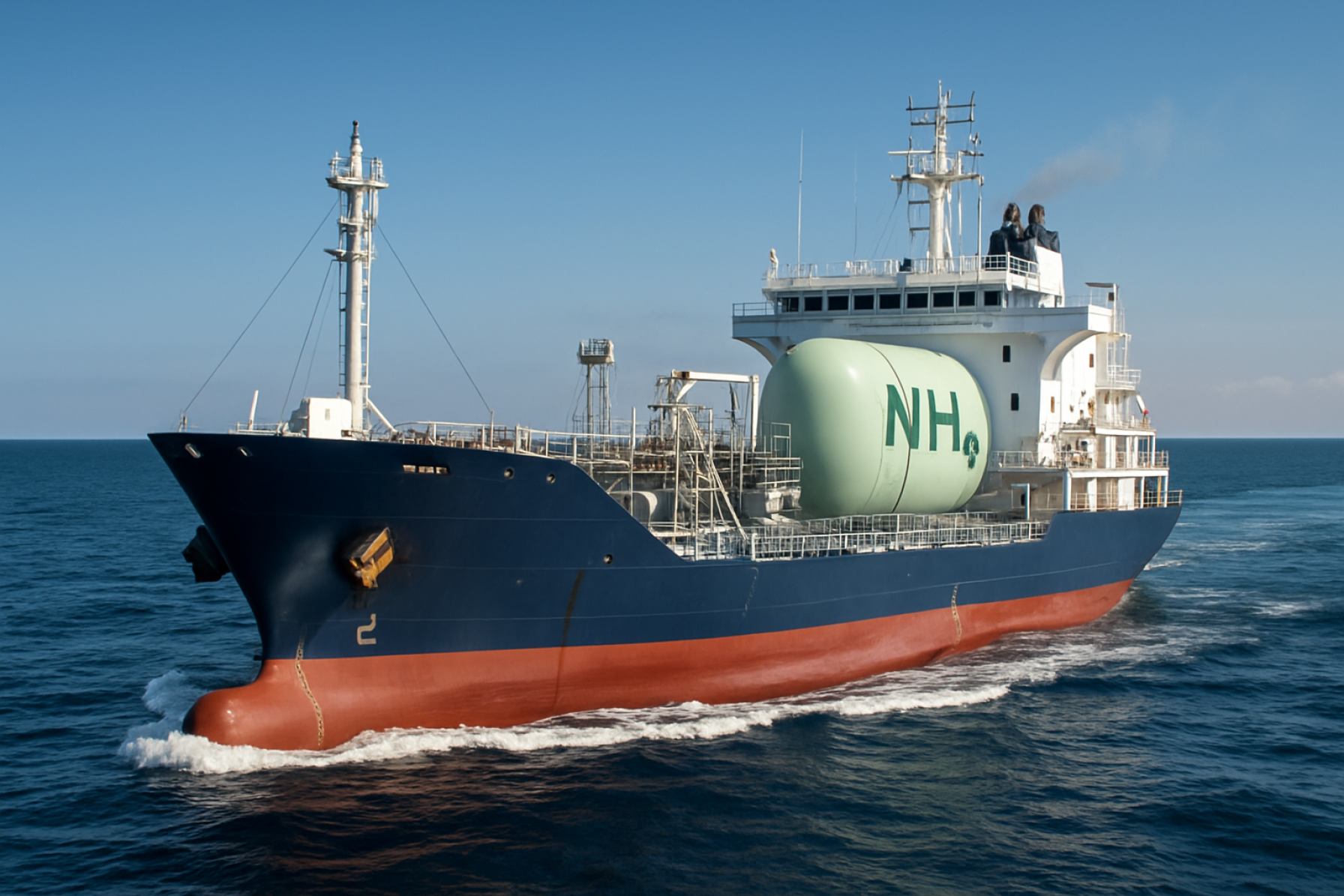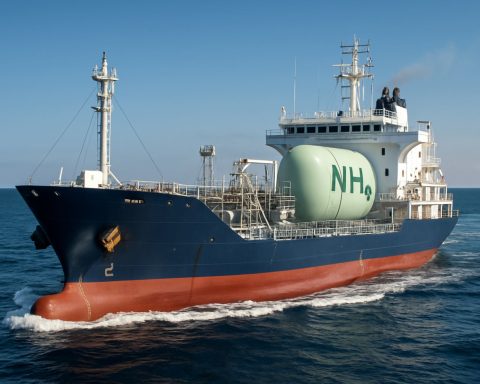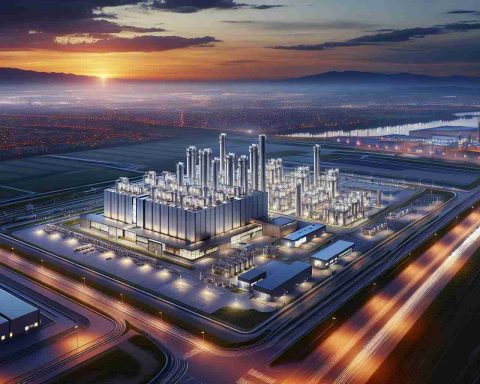Ammonia-Fueled Marine Propulsion Systems Market Report 2025: Navigating Decarbonization, Innovation, and Global Adoption. Explore Key Trends, Market Drivers, and Strategic Opportunities Shaping the Next Five Years.
- Executive Summary & Market Overview
- Key Technology Trends in Ammonia-Fueled Marine Propulsion
- Competitive Landscape and Leading Players
- Market Growth Forecasts and CAGR Analysis (2025–2030)
- Regional Market Analysis and Adoption Rates
- Challenges, Risks, and Regulatory Barriers
- Opportunities and Strategic Recommendations
- Future Outlook: Pathways to Widespread Adoption
- Sources & References
Executive Summary & Market Overview
Ammonia-fueled marine propulsion systems represent a transformative shift in the maritime industry’s approach to decarbonization and sustainable shipping. As the International Maritime Organization (IMO) intensifies its greenhouse gas (GHG) reduction targets—aiming for net-zero emissions by 2050—the demand for alternative, low-carbon marine fuels has accelerated. Ammonia, with its carbon-free molecular structure and established global production infrastructure, has emerged as a leading candidate for next-generation marine propulsion.
The global market for ammonia-fueled marine propulsion systems is projected to experience robust growth through 2025 and beyond. According to DNV, ammonia is among the top three alternative fuels under active development, alongside methanol and hydrogen. The first commercial ammonia-powered vessels are expected to enter service by 2025, with major shipbuilders and engine manufacturers such as MAN Energy Solutions and Wärtsilä investing heavily in dual-fuel engine technology and retrofitting solutions.
Market drivers include tightening emissions regulations, increasing carbon pricing, and growing pressure from cargo owners and financiers for greener supply chains. The International Maritime Organization’s revised GHG strategy, adopted in 2023, has accelerated R&D and pilot projects, with several demonstration vessels and bunkering infrastructure initiatives underway in Europe and Asia. Notably, Yara International and CMA CGM have announced partnerships to develop ammonia bunkering hubs and supply chains.
Despite its promise, the adoption of ammonia as a marine fuel faces challenges, including toxicity, NOx emissions, and the need for new safety protocols and crew training. However, industry consortia such as the Ammonia Energy Association and the Global Maritime Forum are actively addressing these barriers through collaborative research and standard-setting.
In summary, 2025 marks a pivotal year for ammonia-fueled marine propulsion systems, with the market poised for early commercialization and scale-up. Strategic investments, regulatory support, and cross-sector collaboration are expected to drive the transition from pilot projects to mainstream adoption, positioning ammonia as a cornerstone of the maritime energy transition.
Key Technology Trends in Ammonia-Fueled Marine Propulsion
Ammonia-fueled marine propulsion systems are rapidly emerging as a pivotal technology in the maritime sector’s decarbonization efforts. As the International Maritime Organization (IMO) tightens emissions regulations, ammonia is gaining traction due to its carbon-free combustion and established global supply infrastructure. In 2025, several key technology trends are shaping the development and deployment of ammonia-fueled propulsion systems.
- Dual-Fuel Engine Development: Major engine manufacturers are advancing dual-fuel engines capable of operating on both ammonia and conventional marine fuels. Companies such as MAN Energy Solutions and Wärtsilä are conducting large-scale trials and expect commercial-ready engines by 2025. These systems offer operational flexibility and a transitional pathway as ammonia bunkering infrastructure matures.
- Ammonia Combustion Optimization: Research is focused on overcoming ammonia’s low flammability and slow ignition properties. Innovations include advanced fuel injection systems, optimized combustion chamber designs, and the use of pilot fuels to ensure stable ignition and minimize nitrous oxide (NOx) emissions. DNV reports that several prototype engines have demonstrated significant reductions in greenhouse gas emissions while maintaining efficiency.
- Fuel Cell Integration: Ammonia-fed solid oxide fuel cells (SOFCs) are being piloted for auxiliary and main propulsion. These systems convert ammonia directly into electricity with high efficiency and near-zero emissions. Projects led by Yanmar and Nippon Yusen Kabushiki Kaisha (NYK Line) are expected to reach demonstration phase in 2025, targeting both deep-sea and short-sea shipping applications.
- Safety and Bunkering Solutions: Ammonia’s toxicity and corrosiveness necessitate robust safety protocols and specialized bunkering systems. The Lloyd’s Register and International Maritime Organization (IMO) are collaborating on guidelines for safe handling, storage, and transfer of ammonia on board vessels and at ports.
- Retrofit and Newbuild Projects: Shipowners are exploring both retrofitting existing vessels and commissioning newbuilds designed for ammonia propulsion. According to Clarksons Research, over 100 ammonia-ready or ammonia-fueled vessels are on order or under feasibility assessment for delivery post-2025.
These technology trends underscore the maritime industry’s commitment to ammonia as a viable, scalable solution for zero-carbon shipping, with 2025 marking a critical year for commercial demonstrations and regulatory progress.
Competitive Landscape and Leading Players
The competitive landscape for ammonia-fueled marine propulsion systems in 2025 is characterized by a dynamic mix of established marine engine manufacturers, innovative technology firms, and strategic collaborations across the maritime value chain. As the International Maritime Organization (IMO) tightens emissions regulations and the industry seeks viable alternatives to traditional marine fuels, ammonia has emerged as a leading candidate due to its carbon-free combustion potential and existing global production infrastructure.
Key players in this sector include MAN Energy Solutions, which has made significant strides in developing dual-fuel engines capable of operating on ammonia. In 2023, MAN announced successful bench tests of its ammonia-powered two-stroke engine, with commercial deployment targeted for 2025. Similarly, Wärtsilä is advancing its ammonia engine technology, having completed full-scale engine tests and entering partnerships with shipowners and classification societies to accelerate market readiness.
Japanese conglomerates are also at the forefront, with Mitsubishi Heavy Industries and Yanmar investing in ammonia-fueled engine R&D and pilot projects. Mitsui O.S.K. Lines (MOL) is collaborating with engine makers and shipyards to develop ammonia-ready vessels, aiming for commercial launches by 2025-2026.
On the technology integration side, Cummins Inc. and Rolls-Royce are exploring ammonia as part of their broader alternative fuels strategy, focusing on modular engine designs and retrofitting solutions for existing fleets. Startups and research consortia, such as the Ammonia Energy Association, are fostering innovation through pilot projects and knowledge sharing.
- Strategic partnerships are a hallmark of the sector, with engine manufacturers, shipbuilders, fuel suppliers, and classification societies forming consortia to address safety, fuel handling, and regulatory compliance.
- Geographically, Europe and East Asia are leading in technology deployment, supported by government funding and decarbonization mandates.
- First-mover advantage is evident among companies with established R&D pipelines and strong relationships with major shipping lines.
As the market matures, competition is expected to intensify, with new entrants leveraging advances in fuel storage, safety systems, and digital integration to differentiate their offerings. The next 12-24 months will be critical as demonstration projects transition to commercial-scale deployments, setting the stage for broader adoption of ammonia-fueled marine propulsion systems.
Market Growth Forecasts and CAGR Analysis (2025–2030)
The market for ammonia-fueled marine propulsion systems is poised for significant expansion between 2025 and 2030, driven by tightening international emissions regulations and the maritime sector’s urgent decarbonization agenda. According to projections by DNV, ammonia is expected to become a key alternative fuel for deep-sea shipping, with the first commercial ammonia-fueled vessels anticipated to enter service by 2025. This early adoption phase is forecast to catalyze a compound annual growth rate (CAGR) exceeding 30% for the global ammonia marine propulsion market through 2030, as reported by Wood Mackenzie.
Several factors underpin this robust growth trajectory. The International Maritime Organization’s (IMO) 2023 revised greenhouse gas strategy, which targets net-zero emissions from international shipping by 2050, is accelerating investment in zero-carbon fuels and propulsion technologies. Ammonia, with its carbon-free combustion profile, is increasingly favored by shipowners and operators seeking compliance with future IMO mandates. Clarksons Research notes a surge in orders for ammonia-ready and ammonia-fueled newbuilds, particularly among large container ships, bulk carriers, and tankers, beginning in 2025.
Regionally, Asia-Pacific is projected to lead market growth, driven by major shipbuilding nations such as South Korea and Japan, which are actively developing and piloting ammonia-powered vessels. Europe is also expected to see rapid adoption, supported by EU “Fit for 55” policies and green shipping corridors. According to Lloyd’s List Intelligence, the number of ammonia-fueled ships on order or under development could reach 200 units globally by 2030, up from fewer than 10 in 2025.
Despite the optimistic outlook, the market’s CAGR may be tempered by challenges such as the need for scalable ammonia bunkering infrastructure, safety concerns, and the high initial cost of retrofitting or building ammonia-capable vessels. Nevertheless, with major engine manufacturers like MAN Energy Solutions and Wärtsilä advancing commercial-ready ammonia engines, the sector is expected to maintain double-digit annual growth rates throughout the forecast period.
Regional Market Analysis and Adoption Rates
The regional adoption of ammonia-fueled marine propulsion systems is shaped by regulatory pressures, infrastructure readiness, and the strategic priorities of key maritime nations. As of 2025, the Asia-Pacific region, Europe, and select North American ports are at the forefront of integrating ammonia as a marine fuel, driven by decarbonization mandates and investments in alternative fuel infrastructure.
Asia-Pacific leads in both pilot projects and commercial-scale adoption. Japan and South Korea, home to major shipbuilders and shipping lines, are investing heavily in ammonia-ready vessels and bunkering facilities. For instance, Mitsui O.S.K. Lines and NYK Line have announced plans for ammonia-fueled ships, with support from government initiatives targeting net-zero emissions by 2050. Singapore, as a global bunkering hub, is also developing ammonia supply chains and safety protocols, positioning itself as a key node for ammonia refueling in Southeast Asia (Maritime and Port Authority of Singapore).
Europe is accelerating adoption through regulatory frameworks such as the EU Emissions Trading System (ETS) and the FuelEU Maritime initiative, which incentivize low- and zero-carbon fuels. Northern European ports, particularly in Norway, the Netherlands, and Germany, are piloting ammonia bunkering and retrofitting projects. The Port of Rotterdam and Yara International are collaborating on ammonia import and distribution infrastructure, while Scandinavian shipping companies are testing ammonia-powered vessels on short-sea routes (DNV).
- Norway: Government-backed projects, such as the Green Shipping Programme, are supporting ammonia-fueled ferries and offshore supply vessels.
- Netherlands: The Port of Rotterdam is piloting ammonia bunkering and safety standards.
North America is in the early stages of adoption, with regulatory uncertainty and limited infrastructure slowing progress. However, the Port of Los Angeles and Port of Vancouver are exploring feasibility studies and partnerships for ammonia bunkering, anticipating future demand as international shipping regulations tighten (International Maritime Organization).
Overall, while Asia-Pacific and Europe are leading in pilot deployments and infrastructure development, global adoption rates remain modest in 2025, with most activity concentrated in demonstration projects and early commercial orders. The pace of regional adoption will depend on regulatory clarity, safety standards, and the scaling of ammonia production and distribution networks.
Challenges, Risks, and Regulatory Barriers
The adoption of ammonia-fueled marine propulsion systems faces a complex array of challenges, risks, and regulatory barriers as the maritime industry seeks to decarbonize by 2025. While ammonia offers significant potential as a zero-carbon fuel, its implementation is hindered by several technical, safety, and policy-related issues.
One of the primary challenges is the toxicity and corrosiveness of ammonia. Ammonia is hazardous to human health, requiring robust containment, handling, and emergency response protocols on board vessels and at port facilities. The International Maritime Organization (International Maritime Organization) has yet to finalize comprehensive safety guidelines specific to ammonia as a marine fuel, creating uncertainty for shipowners and operators regarding compliance and liability.
Technical risks also persist. Ammonia’s lower energy density compared to conventional marine fuels necessitates larger storage volumes, impacting vessel design and cargo capacity. Additionally, ammonia combustion can produce nitrogen oxides (NOx), which are regulated pollutants. Engine manufacturers are still developing and testing ammonia-compatible engines and aftertreatment systems to ensure compliance with emission standards set by organizations such as the IMO MARPOL Annex VI.
Regulatory barriers are compounded by the lack of harmonized international standards for ammonia bunkering, storage, and fuel quality. The absence of a clear regulatory framework delays investment decisions and slows the pace of infrastructure development. According to DNV, only a handful of pilot projects and demonstration vessels are expected to be operational by 2025, reflecting the cautious approach of industry stakeholders in the face of regulatory ambiguity.
Insurance and financing risks are also significant. Insurers and financial institutions remain wary of underwriting ammonia-fueled projects due to the perceived safety risks and the evolving regulatory landscape. This hesitancy can increase capital costs and limit access to funding, further impeding market growth (Lloyd’s List).
In summary, while ammonia-fueled marine propulsion systems hold promise for decarbonizing shipping, their widespread adoption by 2025 is constrained by unresolved safety, technical, and regulatory challenges. Industry progress will depend on the rapid development of international standards, technological advancements, and coordinated policy support.
Opportunities and Strategic Recommendations
The transition to ammonia-fueled marine propulsion systems presents significant opportunities for stakeholders across the maritime value chain in 2025. As the International Maritime Organization (IMO) tightens emissions regulations and the industry seeks viable alternatives to traditional marine fuels, ammonia emerges as a promising zero-carbon solution. The following opportunities and strategic recommendations are identified for market participants:
- First-Mover Advantage in Technology Development: Companies investing early in ammonia-compatible engines, fuel storage, and bunkering infrastructure can secure a competitive edge. Partnerships between engine manufacturers and shipbuilders, such as those seen with MAN Energy Solutions and Wärtsilä, are accelerating the commercialization of ammonia propulsion technologies.
- Green Ammonia Production and Supply Chain Integration: The demand for green ammonia—produced using renewable energy—will surge as shipping lines seek to decarbonize. Strategic investments in green ammonia production facilities and logistics, as demonstrated by Yara International and OCI Global, can position suppliers as key enablers of the marine energy transition.
- Retrofit and Conversion Services: The existing global fleet offers a substantial retrofit market. Engineering firms and shipyards that develop cost-effective ammonia conversion packages for existing vessels can tap into a lucrative segment, especially as regulatory deadlines approach.
- Port and Bunkering Infrastructure Development: Ports that invest in ammonia bunkering capabilities will attract early adopters and establish themselves as critical nodes in the emerging fuel network. Initiatives by Port of Rotterdam and PSA Singapore exemplify proactive infrastructure planning.
- Collaboration and Standardization: Industry-wide collaboration on safety standards, fuel handling protocols, and crew training is essential. Engagement with organizations such as the International Maritime Organization and Lloyd’s Register can help shape regulatory frameworks and build stakeholder confidence.
Strategically, stakeholders should prioritize R&D investment, cross-sector partnerships, and advocacy for supportive policy frameworks. Early alignment with decarbonization goals and proactive risk management—particularly regarding ammonia’s toxicity and handling—will be critical for long-term success in the evolving marine propulsion landscape.
Future Outlook: Pathways to Widespread Adoption
The future outlook for ammonia-fueled marine propulsion systems in 2025 is shaped by a convergence of regulatory, technological, and economic factors that are accelerating the pathway to widespread adoption. The International Maritime Organization’s (IMO) decarbonization targets—mandating a 40% reduction in carbon intensity by 2030 and net-zero emissions by 2050—are compelling shipowners and operators to seek alternative fuels, with ammonia emerging as a leading candidate due to its carbon-free combustion and established global production infrastructure International Maritime Organization.
Key pathways to adoption in 2025 include:
- Technological Advancements: Major engine manufacturers, such as MAN Energy Solutions and Wärtsilä, are on track to commercialize ammonia-capable engines by 2025, with pilot projects already underway. These developments are expected to lower technical barriers and provide shipowners with viable retrofit and newbuild options.
- Demonstration Projects and Pilots: High-profile demonstration projects, such as the Yara International and Trafigura ammonia-fueled vessel initiatives, are set to launch in 2025, providing critical data on operational safety, fuel handling, and emissions performance.
- Infrastructure Development: Investments in bunkering and supply chain infrastructure are accelerating, with ports in Europe and Asia—such as Port of Rotterdam and Port of Singapore—announcing plans to offer ammonia bunkering by 2025, addressing a key bottleneck for adoption.
- Policy and Incentives: Governments and regulatory bodies are introducing incentives, such as green shipping corridors and carbon pricing mechanisms, to de-risk early investments and stimulate demand for ammonia-fueled vessels International Energy Agency.
Despite these positive trends, challenges remain, including ammonia’s toxicity, NOx emissions, and the need for crew training and safety protocols. However, with the alignment of industry stakeholders, regulatory support, and technological readiness, 2025 is poised to be a pivotal year, setting the stage for ammonia to become a mainstream marine fuel by the end of the decade.
Sources & References
- DNV
- MAN Energy Solutions
- Wärtsilä
- International Maritime Organization
- Yara International
- Ammonia Energy Association
- Global Maritime Forum
- Nippon Yusen Kabushiki Kaisha (NYK Line)
- Lloyd’s Register
- Clarksons Research
- Mitsubishi Heavy Industries
- Mitsui O.S.K. Lines
- Rolls-Royce
- Wood Mackenzie
- Lloyd’s List Intelligence
- NYK Line
- Port of Rotterdam
- Lloyd’s List
- OCI Global
- Port of Singapore
- International Energy Agency













